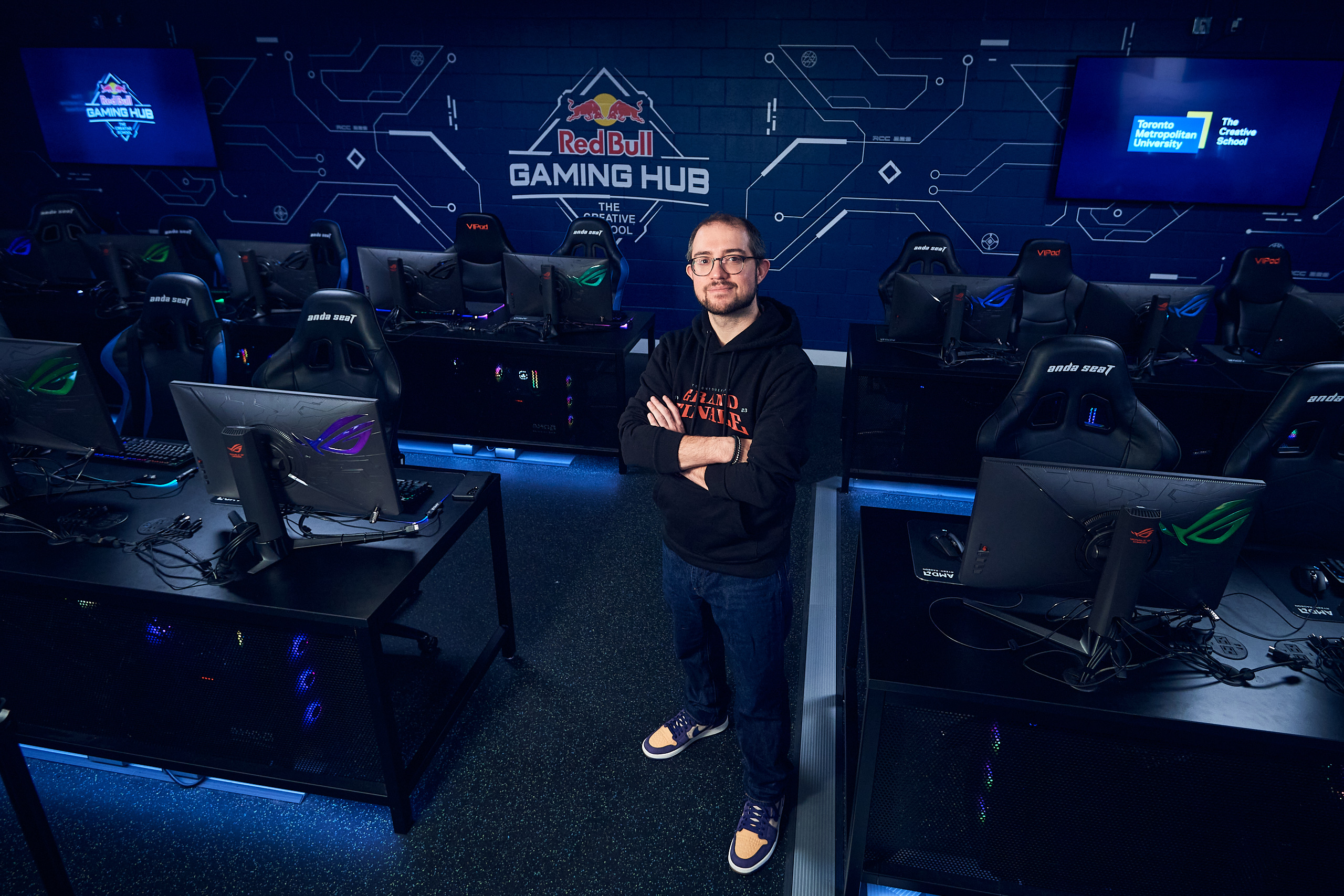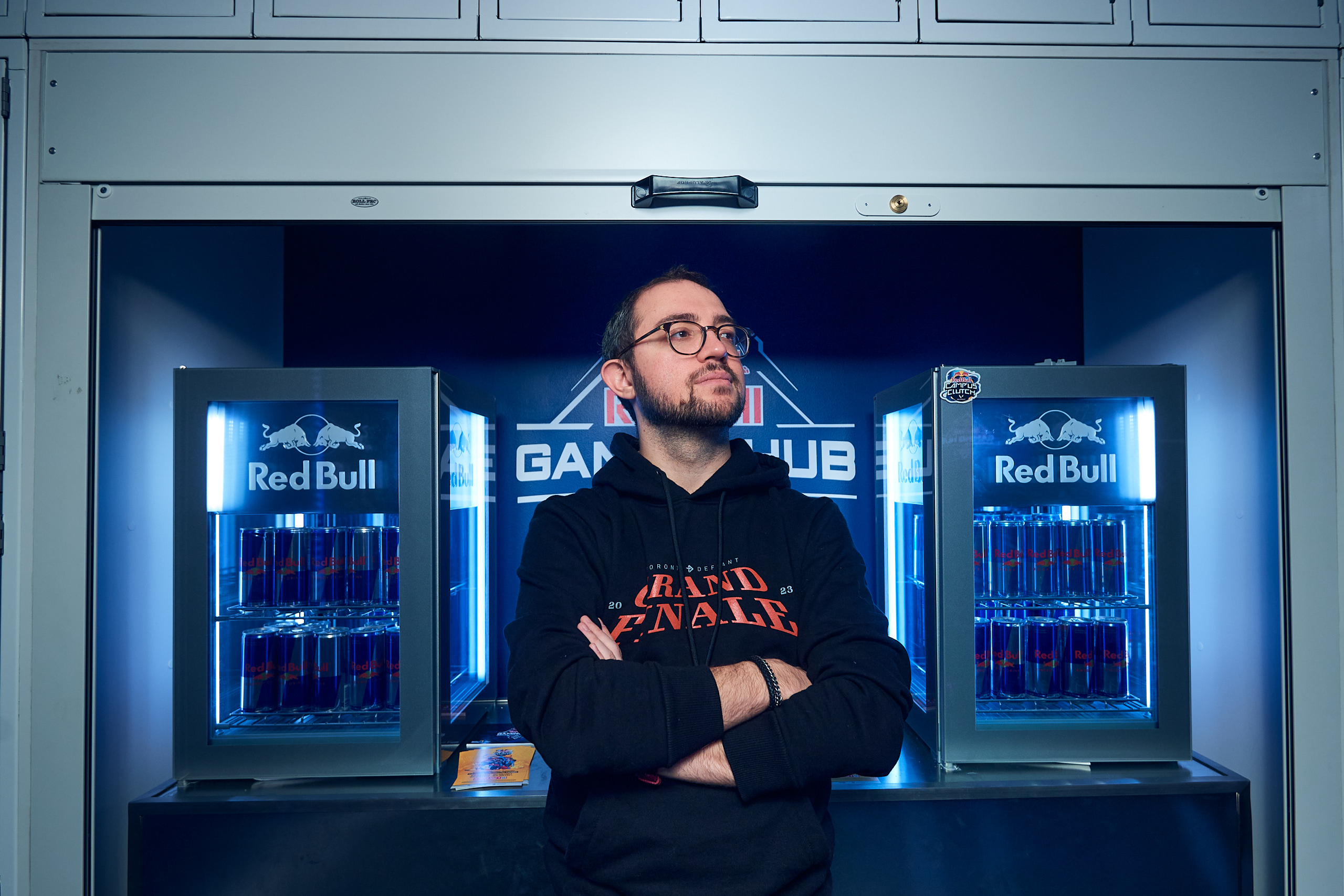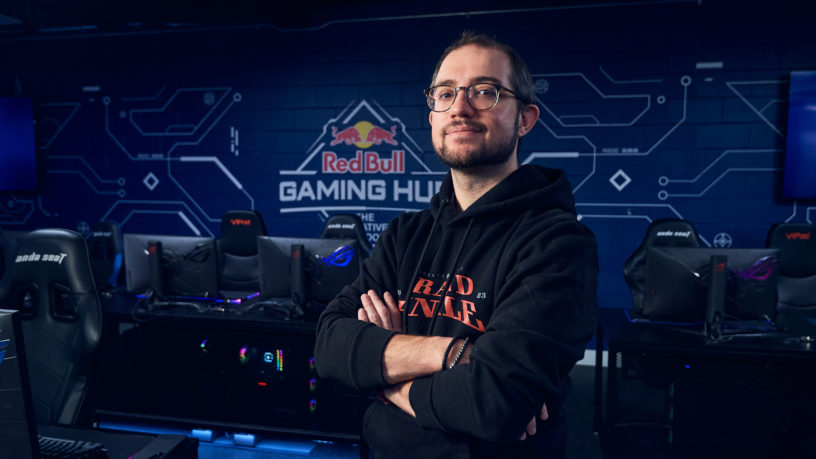By Jake MacAndrew
Photos by Sammy Kogan
*Questions and answers have been edited for length and clarity
With a chessboard atop his desk, cases of Red Bull stacked on the floor and video game consoles aligned on a shelf, Geoffrey Lachapelle doesn’t have a typical office for a university educator.
Aside from teaching classes in esports production and overlooking special projects and partnerships at The Creative School at Toronto Metropolitan University (TMU), Lachapelle is the manager of the school’s Red Bull Gaming Hub.
The hub opened in September of last year for students to get involved in esports in various ways.
Lachapelle says the hub is dedicated to three key esports-related activities—a classroom, a training space and a community centre.
Although TMU students now have the ability to learn about esports in post-secondary education, having a career in professional video games was not a reality for many just a decade ago.
Before starting university, Lachapelle was a competitive Halo 3 player and nationally ranked in the collectable card game Magic: The Gathering. But at the time, he thought a career in video games wasn’t a viable option, so he joined TMU’s media production program followed by a Master of Arts in Media Production.
After graduating from TMU, he says he thought “video game [work] is not really a thing.” So, he got into documentary production at the digital media and broadcasting company Vice Media. The first project he worked on was a documentary about esports.
While conducting interviews for esports documentaries, Lachapelle reconnected with an old friend, assistant professor at TMU’s RTA School of Media Kristopher Alexander, who eventually asked him to teach at the school.
In an industry with multimillion-dollar tournaments, varsity teams, sponsorships and higher education, The Eyeopener asked Lachapelle how esports became the industry it is today and what’s in its future.



JM: You said that a decade ago that esports—from a professional point of view—wasn’t really a viable option as a career. What do you think has changed from then to now?
GL: It’s often forgotten by people who watch esports now—especially games like League of Legends or Counter-Strike or Valorant—it’s 25 years old. I talk to a lot of investors who get very frustrated about the fact that esports isn’t paying out the way they expect, it isn’t getting the [return on investment] they expect, ‘companies are struggling’…spoiler alert, it’s doing fine.
It’s because people see the [National Football League (NFL)] and see the amount of money that the NFL makes. Then [they] look at esports and see that an individual game like League of Legends actually has more main World Championship viewers than in the NFL and wonder why they aren’t making as much money. It’s very simple. Esports is 25 years old while the NFL is almost 100 years old. You have multigenerational fans and dynasties that create a much deeper connection around merch and fan engagement and all these things that still need to be built up in esports.
But ultimately, the thing that drives so much of sports is not the sport itself, it’s the entertainment factor, it’s the halftime show. There’s a large contingent of people who watch the Superbowl just for the commercials and the halftime show, they don’t care about football. Esports is going through the same learning period and the same lessons are learned more quickly.
JM: I want to touch on the Overwatch League finals that were hosted at TMU last month. The event had a packed arena, it was very popular but there was still some negativity because people thought it might be the last Overwatch finals as funding issues continued within the Overwatch League. If it’s so popular then why are some leagues losing funding?
GL: The Overwatch League is an interesting beast because—and I say this as a huge fan of the game Overwatch—I’m a huge advocate for OverActive Media. The Overwatch League specifically had a lot of management issues that were related to the development of the game, like a promised single-player campaign that ended up being cancelled after years of being in the tank. There were a lot of issues with the Overwatch game that had a pronounced impact on the Overwatch League.
The other challenge that the Overwatch League had that’s unique to the Activision titles is [the game] requires that each team be geolocated to a city, which works really well when you’re Toronto’s [team]. The OverActive media team, they do a really good job of engaging with fans and they have a massive city to lean on that historically has a ton of support for its local team associations. Be it the Blue Jays, the Raptors or the Maple Leafs, we really back our teams.
Other cities don’t have that same level of fan backing. And when you make the teams geolocated but then base a lot of your play in North America, it makes it prohibitively expensive for international teams to form that have to be tied to a city like London or Shanghai or wherever. As a result, that gets really challenging for the international teams. It creates a real barrier to fan connectivity. There’s a lot of depth and nuance that is specific to the challenges that the Overwatch League experienced that are not present in other games. It is specifically an Overwatch issue.

JM: What would you say is like the ideal formation for an esports League?
GL: There’s a misconception that you’ll just make an esports game [from a video game]. No, you make a good multiplayer video game and by the product of its fan engagement, it can become an esport. It’s like saying I invented pickleball and pickleball will be the new National League to compete with the NFL and the [National Hockey League]. No, it’s not. The challenge that game publishers running their leagues have is that it creates a two-fold problem. The league participants—a.k.a. your participating teams—need to build fan engagement. But there’s an onus on the publisher to ensure that the game is fun and interesting and maintains fan engagement. So, your best possible league structure should facilitate both the teams and [encourage] them to engage with the game more. But the publisher itself should also be uplifting those teams, helping them ensure that they’re profitable [and] helping them ensure that they’re growing because the more the teams grow, the more spotlight they put on those games.
JM: Obviously there’s money to be made within these games. I read stories about how there are players making $100,000, sometimes millions of dollars in prize money. How is this money generated?
GL: Revenue in esports is a bit of a mixed bag and it really depends on who you are in the chain. With traditional sports, the vast majority of the revenue at the competitive team level is sponsorship money. The challenge with esports is that the players who play are Gen Z and beyond, who are notoriously the most difficult group of customers to activate via a sponsorship deal ever in the history of the world. They’re the most ad-aware people possible. So there have been a lot of sponsors who have dipped their toe in the water and gotten nowhere because their sponsorships don’t actually lead to activations. You have to be smarter with your sponsorship.
A great example of [a company] that’s smart with their sponsorships is actually Chipotle, the burrito company. They did an activation at [the Evolution Championship Series] this year, where everybody who played and won a match got a free meal at Chipotle. That was such a genius idea that by the end of the tournament, people were cheering for the Chipotle ads in between matches as hard as they were for the actual matches because [the tournament] takes place in Las Vegas. So they gave a bunch of kids free meals in Vegas…genius! It used to be in a lot of other sectors—you could just throw money around and just the brand presence generates revenue. As a result, sponsorship money doesn’t generate as much revenue as people would expect because esports is so new.
JM: In what other ways are leagues profiting from sponsorships?
GL: Louis Vuitton is partnered with League of Legends but that’s primarily through the other thing that generates an enormous amount of money in the esports world, which is microtransactions. It’s a controversial topic, especially among video game players. But it’s an undeniable reality that microtransactions are a staggeringly effective revenue model for video games.
Microtransactions are the act of either having a free game or a paid game, but having the opportunity or the option to purchase assets in-game after the fact of installing the game. That could be a costume for your character, icons or flares, little decorations for your character ID in the game—all kinds of things. For reference, League of Legends makes over a billion dollars a year and the game is free. So, a lot of esports titles make a huge portion of their money back in the microtransaction world and many publishers generate revenue for their teams by cutting the teams in on the deal.
JM: Is virtual reality still a thing? Are there any new developments in virtual reality and esports?
GL: I spoke about esports and virtual reality (VR) as far back as 2017 in Nanjing, China. The problem that you’re always gonna have with virtual reality [in esports] has not been solved and can’t be solved without wizard spell technology. Virtual reality is fundamentally an isolating activity because none of the senses other than sight are satisfied. Crucially, without touch being in some way, accurate and true to life, VR is an inherently isolating experience. For example, there is a fundamental barrier to immersion that comes from playing dodgeball, but you can’t physically feel the weight of the ball or have that tactile sense of getting the spin on it. Without that and with the little micro inaccuracies of VR—the idea that if your VR controller misreads and flutters in the virtual reality environment—it could cost you a game. Those issues are going to fundamentally prevent VR from being an esports thing forever until those technical issues are solved. And that requires a huge forward leap in haptic feedback technology and sensor technology at a consumer-grade level.

JM: So what’s going on at the Red Bull Gaming Hub? Is the team going out to these Overwatch tournaments?
GL: As a classroom, [the hub] targets learning in the worlds of video game design and virtual environment design, so essentially how we shape and play video games. [In these classes] we talk about virtual environment design–stuff like a virtual studio production, the leveraging of the same tools that are used to allow Fortnite to create shows like the Mandalorian’s visual effects.
At six o’clock, we hand the room over to our varsity esports program at the university, which is a cross-curricular including all of the curriculums of all of the schools across the university. It is led by students and it competes at some of the highest-tier play among all colleges and universities in North America. Some of our teams notably are in the [highest-ranking] tier of their given games. All of that means that we compete at a very serious level and try to provide our students with a pathway to professional play when we compete at the esports level.
We provide our students with a huge amount of professional experience in addition to academic experience. The school is at the centrepiece of a lot of the strategies driving forward in the city.











Leave a Reply